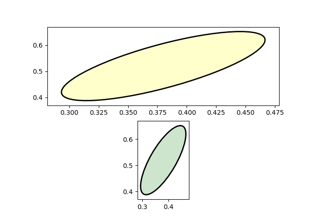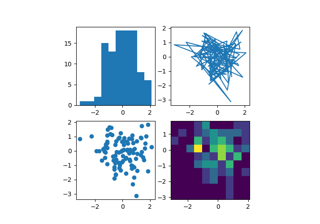matplotlib.patches.Arc¶
-
class
matplotlib.patches.Arc(xy, width, height, angle=0.0, theta1=0.0, theta2=360.0, **kwargs)[source]¶ Bases:
matplotlib.patches.EllipseAn elliptical arc, i.e. a segment of an ellipse.
Due to internal optimizations, there are certain restrictions on using Arc:
- The arc cannot be filled.
- The arc must be used in an
Axesinstance. It can not be added directly to aFigurebecause it is optimized to only render the segments that are inside the axes bounding box with high resolution.
Parameters: - xy(float, float)
The center of the ellipse.
- widthfloat
The length of the horizontal axis.
- heightfloat
The length of the vertical axis.
- anglefloat
Rotation of the ellipse in degrees (counterclockwise).
- theta1, theta2float, default: 0, 360
Starting and ending angles of the arc in degrees. These values are relative to angle, e.g. if angle = 45 and theta1 = 90 the absolute starting angle is 135. Default theta1 = 0, theta2 = 360, i.e. a complete ellipse. The arc is drawn in the counterclockwise direction. Angles greater than or equal to 360, or smaller than 0, are represented by an equivalent angle in the range [0, 360), by taking the input value mod 360.
Other Parameters: - **kwargs
Patchproperties Most
Patchproperties are supported as keyword arguments, with the exception of fill and facecolor because filling is not supported.Property Description agg_filtera filter function, which takes a (m, n, 3) float array and a dpi value, and returns a (m, n, 3) array alphafloat or None animatedbool antialiasedor aaunknown capstyle{'butt', 'round', 'projecting'} clip_boxBboxclip_onbool clip_pathPatch or (Path, Transform) or None colorcolor containsunknown edgecoloror eccolor or None or 'auto' facecoloror fccolor or None figureFigurefillbool gidstr hatch{'/', '\', '|', '-', '+', 'x', 'o', 'O', '.', '*'} in_layoutbool joinstyle{'miter', 'round', 'bevel'} labelobject linestyleor ls{'-', '--', '-.', ':', '', (offset, on-off-seq), ...} linewidthor lwfloat or None path_effectsAbstractPathEffectpickerNone or bool or callable rasterizedbool or None sketch_params(scale: float, length: float, randomness: float) snapbool or None transformTransformurlstr visiblebool zorderfloat
-
__init__(self, xy, width, height, angle=0.0, theta1=0.0, theta2=360.0, **kwargs)[source]¶ Parameters: - xy(float, float)
The center of the ellipse.
- widthfloat
The length of the horizontal axis.
- heightfloat
The length of the vertical axis.
- anglefloat
Rotation of the ellipse in degrees (counterclockwise).
- theta1, theta2float, default: 0, 360
Starting and ending angles of the arc in degrees. These values are relative to angle, e.g. if angle = 45 and theta1 = 90 the absolute starting angle is 135. Default theta1 = 0, theta2 = 360, i.e. a complete ellipse. The arc is drawn in the counterclockwise direction. Angles greater than or equal to 360, or smaller than 0, are represented by an equivalent angle in the range [0, 360), by taking the input value mod 360.
Other Parameters: - **kwargs
Patchproperties Most
Patchproperties are supported as keyword arguments, with the exception of fill and facecolor because filling is not supported.Property Description agg_filtera filter function, which takes a (m, n, 3) float array and a dpi value, and returns a (m, n, 3) array alphafloat or None animatedbool antialiasedor aaunknown capstyle{'butt', 'round', 'projecting'} clip_boxBboxclip_onbool clip_pathPatch or (Path, Transform) or None colorcolor containsunknown edgecoloror eccolor or None or 'auto' facecoloror fccolor or None figureFigurefillbool gidstr hatch{'/', '\', '|', '-', '+', 'x', 'o', 'O', '.', '*'} in_layoutbool joinstyle{'miter', 'round', 'bevel'} labelobject linestyleor ls{'-', '--', '-.', ':', '', (offset, on-off-seq), ...} linewidthor lwfloat or None path_effectsAbstractPathEffectpickerNone or bool or callable rasterizedbool or None sketch_params(scale: float, length: float, randomness: float) snapbool or None transformTransformurlstr visiblebool zorderfloat
-
__module__= 'matplotlib.patches'¶
-
draw(self, renderer)[source]¶ Draw the arc to the given renderer.
Notes
Ellipses are normally drawn using an approximation that uses eight cubic Bezier splines. The error of this approximation is 1.89818e-6, according to this unverified source:
Lancaster, Don. Approximating a Circle or an Ellipse Using Four Bezier Cubic Splines.
There is a use case where very large ellipses must be drawn with very high accuracy, and it is too expensive to render the entire ellipse with enough segments (either splines or line segments). Therefore, in the case where either radius of the ellipse is large enough that the error of the spline approximation will be visible (greater than one pixel offset from the ideal), a different technique is used.
In that case, only the visible parts of the ellipse are drawn, with each visible arc using a fixed number of spline segments (8). The algorithm proceeds as follows:
The points where the ellipse intersects the axes bounding box are located. (This is done be performing an inverse transformation on the axes bbox such that it is relative to the unit circle -- this makes the intersection calculation much easier than doing rotated ellipse intersection directly).
This uses the "line intersecting a circle" algorithm from:
Vince, John. Geometry for Computer Graphics: Formulae, Examples & Proofs. London: Springer-Verlag, 2005.
The angles of each of the intersection points are calculated.
Proceeding counterclockwise starting in the positive x-direction, each of the visible arc-segments between the pairs of vertices are drawn using the Bezier arc approximation technique implemented in
Path.arc.

